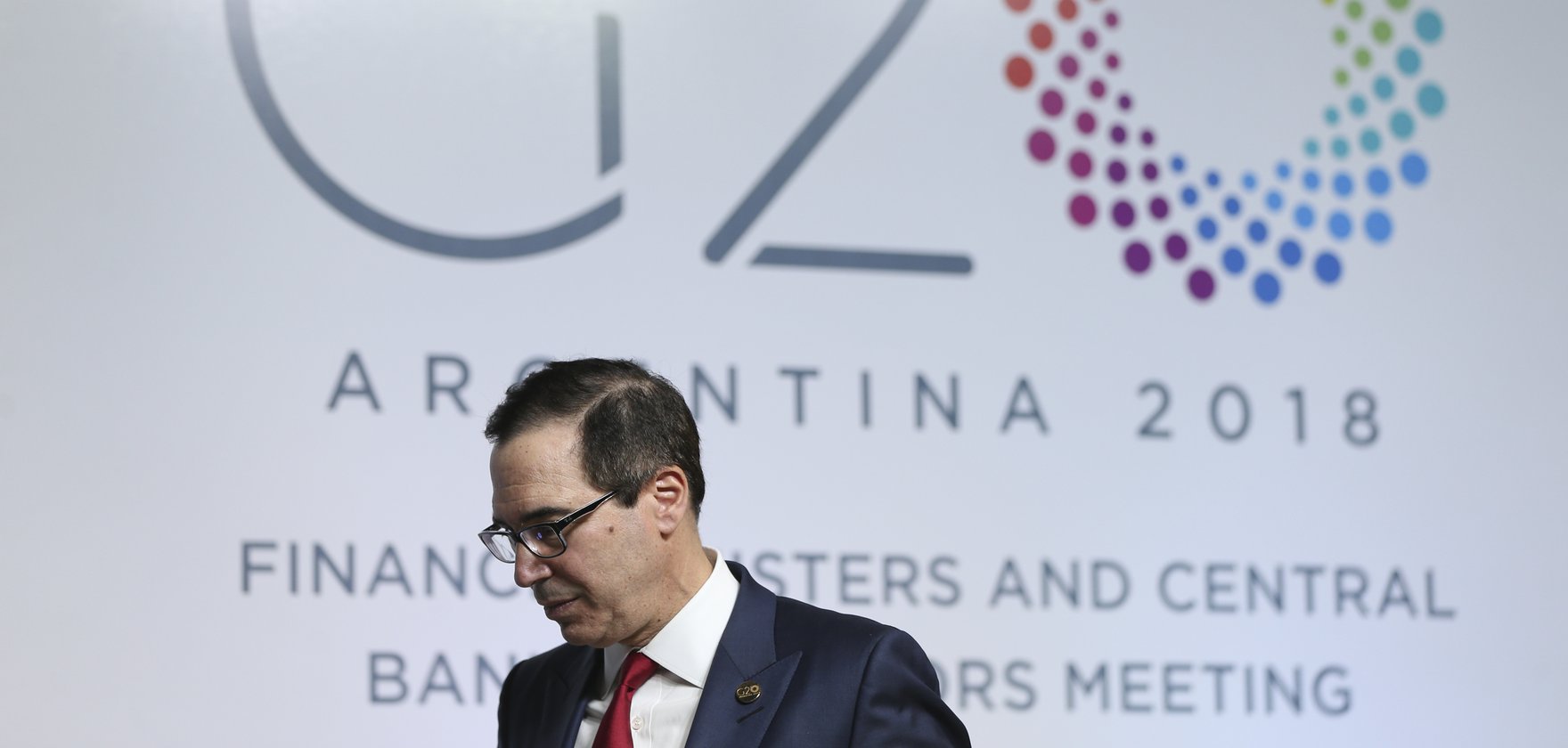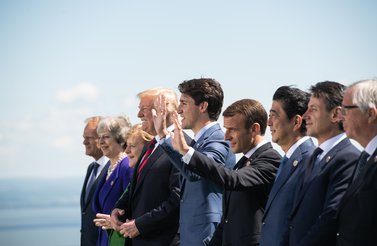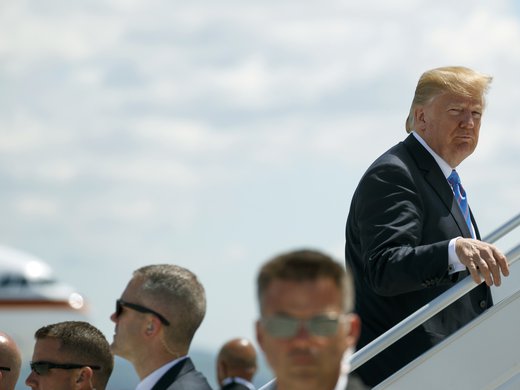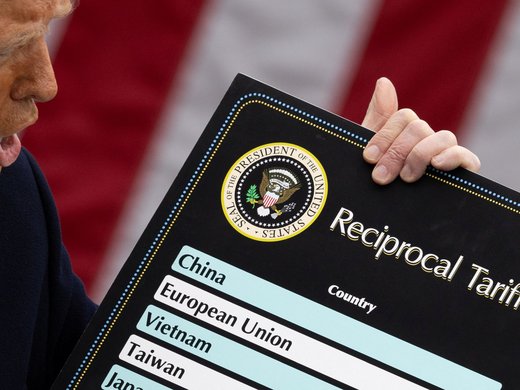The outlook for the Group of Twenty (G20) meeting in Buenos Aires last weekend was stormy. But finance ministers and central bankers caught a break in the weather. The core members of the club are engaged in a trade war, but apparently none of that animosity got in the way of business.
“It was the easiest communique — it was finished yesterday,” Steven Mnuchin, the US Treasury secretary, said at a morning press conference on July 22, the final day of the meeting, according to a report by Bloomberg News.
Mnuchin was referring to the statement that officials typically publish as a record of their discussions. Negotiators agonize over the wording of these documents even at the best of times, so it came as a surprise to learn that talks went so swimmingly at a moment of high tension.
Alas, there was nothing glorious in the G20’s peacemaking in Argentina. Ministers achieved consensus through denial. On trade, all that the top economic policy makers from the world’s leading economies had to say was that they recognized the “need to step up dialogue and actions to mitigate risks and enhance confidence.”
It was an admission of defeat. In the span of a few years, the G20 has gone from setting targets for economic growth, to simply promising to keep the fire trucks shiny and ready to go. It wants no part of Trump’s trade war, even though the IMF warned in Buenos Aires that countries are putting the global economy at risk.
“There is a very clear vision that we have to keep this group alive and functioning in harmony because it is in bad times when we see how important, how key, this group is,” Nicolás Dujovne, Argentina’s finance minister and the host of the latest gathering, told reporters after the meeting ended. “Let’s think about what a key role the G20 played in the 2008-2009 crisis in order to avert the problems of the crisis. It prevented losses that could have occurred.”
In other words: the G20 fights fires, it doesn’t prevent them.
Some will say that’s all that should be expected of the group, which was forged in the aftermath of the Asian financial crisis in the 1990s as a forum for finance ministers, and then elevated to the leaders’ level to fight the Great Recession in 2008.
According to this view, a club whose members include countries such as Australia, Russia and Saudi Arabia is too diverse to agree on anything when there isn’t an existential threat to force co-operation. Therefore, any meeting is a success so long as leaders and ministers all show up, because that signals that the lines of communication are still open.
By that low standard, the meeting in Argentina was a success.
“There is a clear understanding by everyone that an own goal should be avoided,” Scott Morrison, Australia’s treasurer, told the Financial Times, adding that he would leave Buenos Aires feeling better about the state of the global economy than when he arrived. Morrison even expressed some sympathy for the Trump administration, telling Bloomberg that “there are some grievances that have been around for a decade and the tit-for-tat announcements on tariffs were an unconventional way to resolve those issues.”
Simply getting along wasn’t always the height of the G20 ambition.
During the crisis and in the years immediately after, it resolved to resist protectionism. At the Brisbane Summit in 2014, leaders set an “ambitious” goal of lifting their combined GDP by two percent above the IMF’s baseline estimate by 2018. More recently, the G20 set up a task force to do something about the global glut of steel that was depressing prices and killing jobs in the United States, Europe and elsewhere.
But aside from its handling of the financial crisis, the G20’s relatively short history as a leaders’ forum is one of failure. The group’s members struggled to resist the political urge to put up trade barriers, and the promise to guard against protectionism was dropped when US President Donald Trump joined. Efforts to reduce the oversupply of steel voluntarily accomplished little, as the US tariffs attest.
The most embarrassing flop is the pledge to supercharge global economic growth. Under the Australian presidency, the G20’s members went to the trouble of declaring all the policies they would enact to generate more wealth. The final list consisted of some 800 measures.
Most of the promises were vague, and few were new. Nonetheless, the IMF, the Organisation for Economic Co-operation and Development and the World Bank set out to keep track. They soon gave up.
The G20 made additional growth promises at Antalya, Turkey, in 2015, but a year later it was woefully behind schedule.
“The Brisbane goals seem out of reach,” the IMF said in its surveillance note for the 2016 summit in Hangzhou, China. The fund didn’t bother to mention Brisbane ahead of the Hamburg Summit in Germany the following year, nor did it reference the GDP pledge in its economic overview for the Buenos Aires meeting, even though this year was the original target for increasing output by the additional two percent.
“Lifting medium-term growth prospects is critical — and there is ample scope for additional reforms across the G-20,” the IMF said.
Maybe Dujovne is right, and the best that can be hoped for right now is to keep increasingly isolationist countries such as the United States, Russia and Turkey in the fold.
But achieving that goal will further diminish the G20’s dwindling stores of credibility. Trump certainly is capable of quitting the group, which would be temporarily disruptive. It would be just as dangerous to allow public support for the G20 to drain away. Democratic members of the group invoked international unity to help them enact unpopular policies during the financial crisis. It’s easy to imagine voters beginning to question why they should get behind the agenda of an outfit that had done little to strengthen the global economy and had no answer for a possible trade war.
It was fair to expect more of the G20 in Buenos Aires. Mike Callaghan, the former senior Australian Treasury official who now is a non-resident fellow at the Lowy Institute, said the non-American ministers could have pledged to avoid retaliatory tariffs, a concrete step that would reduce the economic threat of Trump’s trade agenda.
“G20 finance ministers need to get real and signal that a tit-for-tat trade war will seriously damage growth, even if the US will not sign up to such a message,” Callaghan said in a commentary published on July 24. “The US needs to be isolated and not accommodated.”
Alas, it might already be too late for that. Core G20 members such as China, the European Union, Canada and Mexico have already taken Trump’s bait, issuing tariffs of their own on tens of billions of dollars of US imports.
Those countries could potentially use a G20 commitment to forego retaliation and a reason to resist escalation. Of course, that assumes members are driven only by what is best for the global economy. It must be said that it’s politically useful to be seen as a leader who is willing to stand up to a bully; Canada’s tit-for-tat tariffs have the support of every political party. The country’s foreign affairs minister, Chrystia Freeland, insists the government had “no choice” but to retaliate, an odd statement because at least a few of America’s trading partners have opted to hold fire.
Whatever the reason, the G20 has signalled that it has nothing to offer when it comes to trade. But, don’t worry — it will be around to put out the fire.




